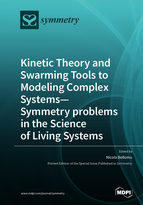Kinetic Theory and Swarming Tools to Modeling Complex Systems—Symmetry problems in the Science of Living Systems
A special issue of Symmetry (ISSN 2073-8994). This special issue belongs to the section "Life Sciences".
Deadline for manuscript submissions: closed (29 February 2020) | Viewed by 23659
Special Issue Editor
2. Professor Emeritus at the Polytechnic University of Torino, Torino, Italy
Interests: kinetic theory; cancer modelling; social systems; crowd dynamics
Special Issues, Collections and Topics in MDPI journals
Special Issue Information
Dear Colleagues,
This Special Issue aims at presenting scientific articles devoted to research perspectives focusing on modeling, qualitative analysis, and simulations of large systems of interacting living entities by kinetic theory and swarming approaches.
The key concept pushed forward in the issue is a multiscale vision and interpretation by mathematical models of living systems from the micro-scale to organized networks. The overall content is multidisciplinary, as it aims at focusing on vehicular traffic and crowd dynamics, where human behaviors are taken into account, as well as behavioral economy, biology, and animal swarms. More in general, this issue looks at the interactions between the so-called hard sciences and the new science of living systems.
New concepts of symmetry and asymmetry are planned to be presented, looking ahead to a possible future of the science of living systems by advanced tools of mathematics, physics, and computer science.
Prof. Nicola Bellomo
Guest Editor
Manuscript Submission Information
Manuscripts should be submitted online at www.mdpi.com by registering and logging in to this website. Once you are registered, click here to go to the submission form. Manuscripts can be submitted until the deadline. All submissions that pass pre-check are peer-reviewed. Accepted papers will be published continuously in the journal (as soon as accepted) and will be listed together on the special issue website. Research articles, review articles as well as short communications are invited. For planned papers, a title and short abstract (about 100 words) can be sent to the Editorial Office for announcement on this website.
Submitted manuscripts should not have been published previously, nor be under consideration for publication elsewhere (except conference proceedings papers). All manuscripts are thoroughly refereed through a single-blind peer-review process. A guide for authors and other relevant information for submission of manuscripts is available on the Instructions for Authors page. Symmetry is an international peer-reviewed open access monthly journal published by MDPI.
Please visit the Instructions for Authors page before submitting a manuscript. The Article Processing Charge (APC) for publication in this open access journal is 2400 CHF (Swiss Francs). Submitted papers should be well formatted and use good English. Authors may use MDPI's English editing service prior to publication or during author revisions.






